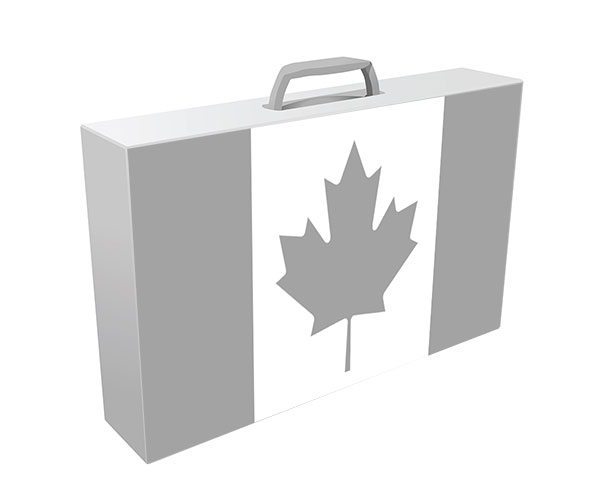Taxes on Investment Income in Canada
 There are four types of investments you need to understand when dealing with income tax in Canada; the interests and other investments income, the eligible dividends, the non-eligible dividends, and capital gains. These four types of income are included in the same provincial and federal tax brackets as the employment one, but most at a modified amount and rate. The marginal rate is applied on the investment income, with the calculations starting after the last income received. Nevertheless, they can still reach superior brackets, and each type of investment income is treated differently.
There are four types of investments you need to understand when dealing with income tax in Canada; the interests and other investments income, the eligible dividends, the non-eligible dividends, and capital gains. These four types of income are included in the same provincial and federal tax brackets as the employment one, but most at a modified amount and rate. The marginal rate is applied on the investment income, with the calculations starting after the last income received. Nevertheless, they can still reach superior brackets, and each type of investment income is treated differently.
Interests and other similar investment income
Interest income comes from investments in Canada Saving Bonds, Guaranteed Investment Certificates (GIC), Treasury-bills (T-bills), Strip Bonds, foreign dividends and other similar kinds of investments.
No favorable treatment is applied, unless the investment is registered under the Registered Retirement Savings Plan (RRSP) or Tax-Free Savings Account (TFSA), which are in part exempt from taxes. Interests and other investment income are taxed like extra employment revenue (salary) and the rates and brackets used are the same as in the employment income bracket.
Dividends from Canadian businesses
Dividends are investment income derived from a company's shares. As a shareholder, you own part of the business, and at times, you have the privilege of receiving a portion of the profits. Tax rates on dividends are lower than on employment income, because dividends are the distribution of the business' profits after tax; therefore, the government has already collected taxes on the company's earnings. Governments will avoid taxing the same income twice, however, since individuals are taxed higher than corporations, there is a remaining portion that will be taxed and will need to be paid by the individual.
The calculation's principle is to take the dividends that would have been distributed before taxes, deduct from the personal taxes the part applicable to the corporation, and then tax the difference applicable to the individual. To do so, the dividends are increased by a gross-up rate to hypothetically reflect the dividends distributed before corporate taxes. After that, the grossed-up dividends are introduced in the personal tax bracket, but the rate of the respective bracket is decreased by the dividend tax credit (DTC). The DTC is an equivalent rate to the federal and provincial corporate tax rate. An example is illustrated below to help better understand this concept, but first we need to go over the different rates associated with the two types of dividends.
From a fiscal point of view, there are two types of dividends issued by Canadian businesses, and both are differently taxed: the eligible and non-eligible Canadian dividends. The eligible dividends are favourably taxed, as opposed to the non-eligible dividends, which involve lower gross-up rates and DTC. The eligible dividends come from businesses that are subject to the general corporate tax rate, and the non-eligible dividends are issued by businesses that benefit from small business deductions. Since the businesses that are eligible of small business deductions are paying at a lower tax rate, the gross-up rate and DTC are decreased, and therefore personal taxes increase.
In 2018 and 2019, the gross-up rate (which is applicable everywhere in Canada) is 38% for eligible dividends. For non-eligible dividends it was 16% in 2018 and 15% in 2019. The Federal enhanced DTC for eligible dividends is 15.02% and the small business DTC for non-eligible dividends was 10.0313% for 2018 and 9.0301% for 2019. At a provincial level, every province registers a different corporate tax rate, so each one has their own DTC rates. These rates are not progressive, they stay fixed and decrease the grossed-up dividend tax rate for every bracket.
If we take eligible dividends of $100.00 for example, the income included in the tax bracket (after applying the gross-up rate of 38%) will be $138.00 calculated as follows: $100.00 * (1 + 38%) = $138.00. This will be the taxable amount combining the federal and provincial rates which will be applicable.
So, if we take an individual tax rate of 40%, the payable tax would be 40% * $138.00 = $55.20. However, the federal DTC of 15.02% and 14.98% from the provincial (hypothetical provincial DTC to round up the calculation) will reduce the tax rate by 15.02% + 14.98% = 30%, which would be a deduction of $138.00 * 30% = $41.40. The tax payable on the $100.00 dividends will then be $55.20 - $41.40 = $13.80, which ends up being 13.8% instead of 40%.
In this example you can see that the grossed-up dividends which are included in the tax brackets are the ones used, meaning that the tax calculation is done on a higher amount than the one you actually received. Consequently, the grossed-up dividends will reach a superior tax bracket more rapidly, which does not play in the investors' favour. In the case the employment income is very low, it is possible for the dividends to have a negative tax rate, because the first bracket rates are rather low and the DTC's are fixed. The negative amount is not a reimbursement, it just decreases the payable taxes.
The factors and rates used on the dividends are an estimation created by the governments to ease tax reports. The gross-up factors in which the dividends are increased in order to obtain before-tax dividends and DTC, don't actually reflect an exact transfer from corporate to personal income taxes, but the result can be very close. The government aims to establish an equation that will bring them approximately the same amount of corporate taxes in the end, no matter how a business redistributes its profit. Moreover, the rates and factors can be readjusted when corporate tax rates fluctuate; if they decrease, the DTC rate will decrease as well.
Capital gains
Capital gains derive from the sale of a financial title or real estate propriety which increased in value from its initial purchase price. Selling and cashing a share or real estate at a higher price than its original purchase value (net of transaction costs) is another form of investment income, and in the fiscal world, it is treated differently than other investments.
Its tax calculation is simple; only half of the capital gain income is taxable, and in the case of real estate, taxation only applies if it's not the owner's main residence. In this situation, we tend to apply half of the marginal rate on the entire capital gain, which is not totally exact. Income taxation in Canada is applied on several income brackets at a progressive rate. The rate increases for every additional income revenue bracket instead of just one rate on the total income. Therefore, if only half of the capital gain is taxable, you need to consider all other revenue in order to apply the right tax bracket.
Another fiscal advantage from capital gains is that they are only taxable when the asset has been sold and the amount cashed, so the gains from the transaction must have been obtained. While the tax on interest and dividend income is paid annually, you can retain a stock, bond or real estate over time which can appreciate indefinitely without paying income tax, until its sale.
Differentiating between interests, dividends and capital gains in your portfolio
The different tax rules applicable on investment income should influence the choices you make when investing. For instance, to get the same result after taxes, dividends and capital gains require a lower return than interest income since they are not as severely taxed. In addition, the risk and term duration aspects should influence the type of investment you decide to obtain for your portfolio. It is important to understand the impact investment income taxation has in order to make an enlightened decision.




